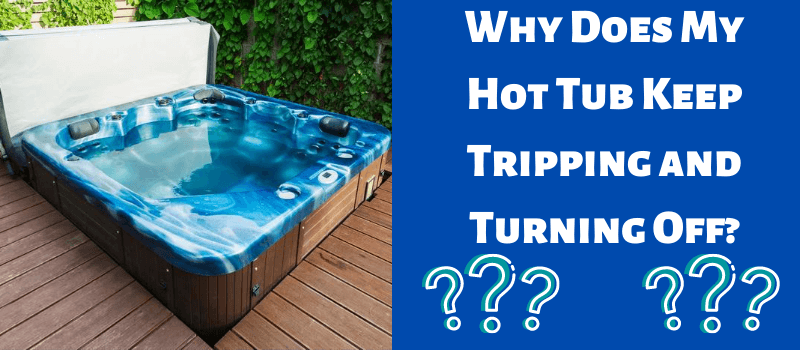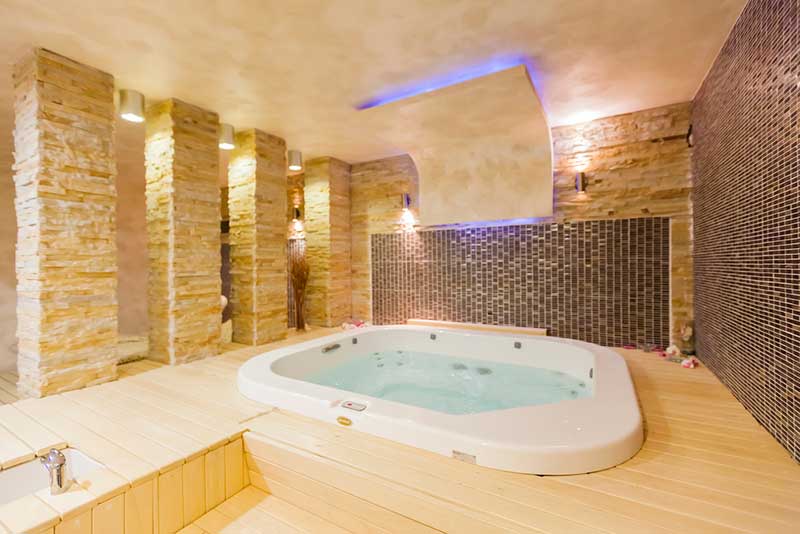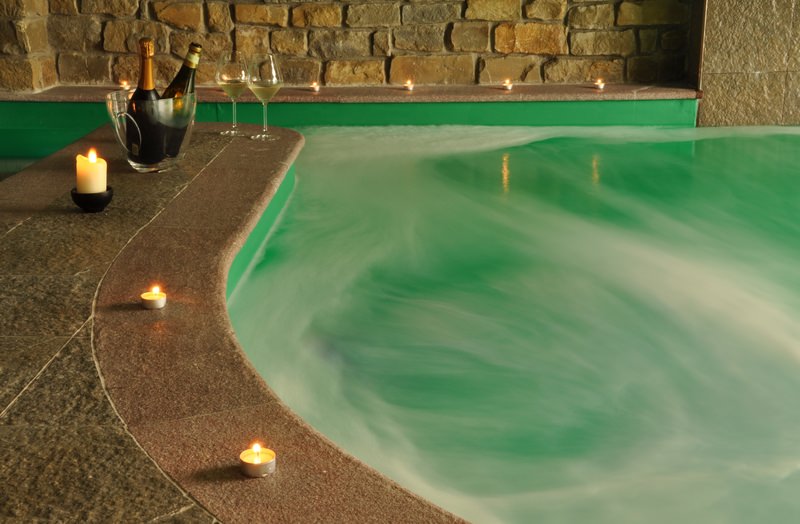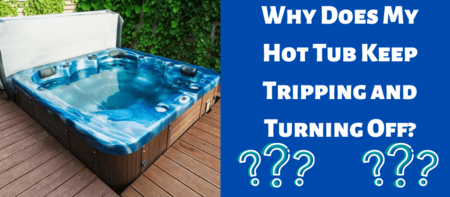
Now that the summer season is back again I was looking forward to spending some time enjoying my hot tub in the garden, but unfortunately, I discovered a problem. Every time I turned the pump on, the tub kept tripping and switching itself off. I needed to find out what was going on so I decided to do some research.
So, why does my hot tub keep tripping and turning off? The problem could be due to a worn GFCI breaker, moisture or corrosion inside the breaker box, damaged or loose wiring, or malfunctioning components. It could even be down to a bad heating element or a flooded blower.
Although it’s irritating to have the breaker trip every time you hop in the tub, it’s important to remember that it does this to protect you from injury and to protect your household’s circuits from overloading. Nevertheless, finding the cause of your hot tub tripping is obviously essential if you’re going to carry on enjoying a relaxing soak in your spa.
Is There a Problem With My Breaker Box?
One of the main reasons that a hot tub breaker keeps tripping is that there is something going on that shouldn’t be inside the breaker box. If you open the box and shine a torch inside, you may find that there is excess moisture in there. Water that has splashed out of the tub, heavy rain, or flooding could have caused sufficient dampness to cause the hot tub’s GFCI to flip.
Luckily, there’s a solution to this. You can try drying out the interior of your breaker box using a towel, or you could use a dehumidifier or fan close to the outlet until the moisture has dried up, then you can reset the breaker afterwards.
In many cases, this will resolve the problem. However, if the breaker continues to flip even when it seems to be completely dry, you’ll have to look a little more closely into the issue. Also, if your breaker has this moisture problem frequently, it’s possible the outer box will need replacing completely, or it may even need to be moved further away from your spa.
Another problem you may encounter inside your breaker box is corrosion. Unfortunately, rust can build up virtually anywhere, so it’s always wise to check for corrosion when you carry out servicing and maintenance on your tub to prevent the problem from getting out of hand.
Inside the hot tub corrosion causes malfunctioning of the components, and this could, in turn, affect the water’s chemistry, or even cause more damage once the components fail completely. For example, the filtration system could fail to function properly and result in unwanted contaminants getting into the water where they could cause health issues for you and any other bathers.

Corrosion may occur close to the hot tub’s GFCI or even around the components of the spa themselves. This is why it’s so important to inspect both the breaker box and inside the spa cabinet itself to see if there are any clear signs that corrosion has occurred.
Corrosion looks like a whitish colored powder, or it may just look like rust forming around the connectors of the components. Inspect the wire connectors, the control panel, the ground wires and any other areas where component wiring can be seen to make sure that there is no evidence of corrosion.
If you do find corrosion, repairing it will depend on both its location and how extensive the corrosion is. It’s possible that you could simply clean the corroded connectors using an electrical contact cleaner or a wire brush then reconnect them.
However, if there is very extensive corrosion, you will probably have to replace the wiring. If you discover that dripping water has caused the corrosion, you’ll need to repair the leak in the spa.
Remember that the combination of water and electricity is a potentially dangerous one and, if you are in any doubt about how to make an electrical repair on your hot tub you should consult a qualified hot tub repairer or electrician.
Could The Problem Be Damaged Wiring?
Damaged or worn wiring could also possibly be the cause of the problem. You should look for char marks or breaks, and make sure that all the connections are snug.
One of the problems that may occur with the wiring is a wiring short circuit. If two wires are touching when they aren’t meant to, a power surge will cause the breaker to trip. It’s possible this could also happen if a wire that has power going to it then touches one of the ground wires.
Sometimes, wires can touch each other accidentally in this way if you’ve carried out some maintenance work in the cabinet, if the spa has recently been moved or if a pest has got into the cabinet.
If you have discovered this problem, you can determine which wires are at fault by disconnecting all of the components one by one then flipping the breaker to see if it trips after each one. As soon as it trips, you’ll have pinpointed the component that is responsible for the problem. If wires are touching each other because one is loose, it’s possible to reconnect then reset the breaker.

If you discover that there are signs of a pest such as a mouse nest, you’ll need to look more closely for any other problems like chewed wires. In such cases, replacing the connectors and wires may be necessary.
When you’re dealing with electricity, there’s always the possibility of a fire. If there is a wiring short, a fire could easily occur. Old wiring may overheat and hot components may also damage the wiring. While you’re checking inside the breaker box, use a torch to look for any wires that have melted insulation or black spots.
If you discover burned wiring, it will not only need to be replaced but you’ll also need to work out why the wire got so hot. It’s best to hire an electrician to find out why this has occurred and to repair the problem.
It isn’t only loose wiring that could have caused the problem, it could be loose connectors. If work has been carried out on your tub, if it has been moved about or if it’s getting old, the wiring connectors may loosen. Even if the wires are just slightly loose it could cause interruptions in the electric circuit and this could cause the GFCI breaker to trip.
Luckily, it’s relatively simple to fix loose connectors. Just use a screwdriver to tighten up the screws that are keeping the wires held in place. Or, if there are plug-style plastic connectors, these may have moved out of place, so give them a push to make sure they’re properly fitted. Any connectors that are damaged or broken will need to be replaced.
Could Malfunctioning Components Cause The Tub To Trip?
Every spa has some electrical components like a heater. Even the most basic inflatable tubs will have a heater and a control panel. If you’ve got a more advanced hot tub with lots of features, it could have a host of exciting features like interior lighting, a sound system or towel warmers. These all contain electrical components that could be misbehaving. This could be causing the breaker to trip.
If you need to isolate the component that is causing the problem, you’ll need to disconnect as many components as possible from the GFCI. Once you’ve done this, connect each one individually then flip the breaker after each one. Once it has tripped, you’ll have identified the culprit.
Unfortunately, identifying which component is guilty of tripping your tub is just the first step to rectifying the problem. You then need to work out how it’s malfunctioning and why. Could the wiring be bad? Has the component overheated? Perhaps it isn’t grounded correctly? Maybe the device has been completely destroyed? Since this is complex troubleshooting, you should use an electrician’s services to find out what’s causing the problem and to rectify it.

One hot tub component that is most likely to be causing the problem is its heating element. The spa heater assembly will be a metal tube containing the heating coil. The water in the tub will pass through this housing to get heated up. When the coil isn’t warm, the water doesn’t heat up. When something has caused this element to malfunction, you’ll find the hot tub breaker tripping.
There are several potential issues that could be causing the heating element to malfunction. One of those issues is a bad heating element. You can determine if this is the problem by disconnected the hot tub heater from the breaker then flipping the switch. If the GFCI doesn’t trip when the heater hasn’t been connected to it, you’ll probably have to replace the heating element.
Another potential issue is a short in the heating element. Disconnect the power to the heating element then take it out of the housing. You can then test the resistance between the element’s two terminals with a multimeter. If the reading is very high or very low, this indicates the element is bad. On the other hand, if the reading comes out normal, you could test to see of there’s a short to the ground. This also requires replacement.
One further issue that could be occurring with your hot tub heating element is dry fire. If the element quickly overheats without adequate water flowing through it, the result can be a dry fire. The housing of the heater may look burned or melted, and you’ll see evidence of damage on the element itself.
If you notice this, you’ll have to replace the tub’s heating element. You may also need to replace the housing if it has experienced damage. Not only that, but you’ll also need to repair the dry fire’s cause. This could be due to anything from clogs that have caused a low flow to poor water chemistry causing deposits to build up. It could be a circulation problem, or even a failure of the thermostat, high limit switch or other failsafe component. You’ll probably need the help of a professional to determine what is going on and to fix it.
If neither of these causes are at the heart of your hot tub tipping, it could be a flooded air blower that’s causing the problem. If water is flowing back into your air blower, this could be causing the breaker to trip. The issue can be troubleshooted by disconnecting the air blower from the breaker then flipping it. It’s likely that this issue has occurred because the check valve is bad or because you have overfilled your hot tub.
In both of these instances, water will come back through your check valve into the blower. You can fix the issue by draining some of the water from the tub when necessary then replacing the check valve. Should the blower be wet, it may require replacing.
Does A Worn GFCI Breaker Cause A Tripping Problem?
One of the most obvious reasons for a hot tub to trip its breaker switch is because the breaker itself is simply worn out. Power surges, age and even lightning strikes nearby may cause fatal damage to the breaker. Luckily, it’s quite easy to work out whether your hot tub breaker is beyond repair.

Simply try flipping the breaker and see if it trips immediately again. If it does, a bad or worn out breaker may be the problem. To make sure, disconnect all of the components from the GFCI then flip the breaker back on. Should it still trip even when nothing is connected you’ll have to replace the breaker. This should resolve the problem so that you can continue to use your hot tub uninterrupted.
Can I Repair A Tripping Hot Tub Myself?
Some of the issues that cause a hot tub breaker to trip can be resolved without any kind of professional help. You can certainly take a look inside the breaker box yourself to see if there are any obvious signs of damage or corrosion, even if you have no experience of working with electrical circuits. However, if you spot a problem, you may feel more comfortable calling in a professional electrician with experience in working with hot tub circuitry to fix the problem.
It can be dangerous to work around electricity, and this is doubly the case when you’re working close to water, so unless you have experience and training in working with electrical circuits you shouldn’t touch the hot tub components yourself. A skilled electrician will be best-placed to investigate the issue and to pinpoint the cause of the problem. They will then be able to repair it quickly and efficiently so you can get back to enjoying your hot tub.
Related Questions
What are the most common hot tub problems? There are a number of common issues that affect hot tubs, however by far the most common include the tub failing to heat up, the jets failing to function properly, the control panel showing an error code, a noisy pump, weak water flow, and, of course, a tripping breaker.
All of these problems can be rectified by a trained electrician with experience in working with hot tubs, and many of these issues can even be prevented in the first place by taking the time to maintain your tub correctly on a regular basis.
How can I properly maintain my hot tub? Maintenance is the key if you want your hot tub to continue functioning properly so that you can enjoy a warm relaxing soak whenever you feel like it. So, how do you maintain your spa?
Age and wear and tear all take their toll on the hot tub’s components and sometimes those parts will need to be replaced due to ongoing use. Inevitably, problems will crop up over time, but if you carry out a proper maintenance schedule on the tub and its parts, you should be able to identify any potential issues before they get out of hand.
You can keep your tub working at the optimal level by creating and sticking to a regular maintenance schedule for your hot tub including regularly balancing the water chemistry, cleaning out the filters, and topping off a low water level as soon as it’s spotted to guard against dry fire, sputtering jets and error codes.
Make sure to open the cabinet occasionally and check the wiring for any signs of damage or any evidence of moisture and leaks. If you spot them early, you can rectify them before they cause major damage that could be difficult and expensive to fix.
Whenever you identify a potential issue, make sure to call in the help of a professional so that you can be certain of getting the problem fixed properly first time. This will save you money in the long run and will also make sure that you stay safe every time you get in the water.

